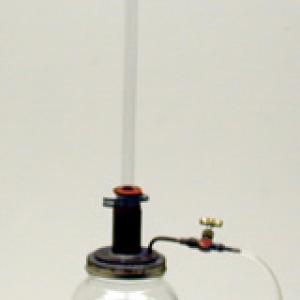College of Liberal Arts & Sciences
4B10.65 - P-V-T App. - Rüchhardt's Method
The P-V-T Apparatus needs to have some special precautions observed. The glass tube is special in that it has a very precise diameter throughout and the ball bearing that fits into the tube has been acid etched to fit that tube. Make sure they are kept clean and free of dust as this will greatly hinder the working of the apparatus. A magnet can be used to return the ball bearing to the top of the glass tube. Different gases may be used to give different vibration rates as described in the manual in the file. This apparatus has also been used in the past to show simple harmonic motion under some special conditions and applications.
- Laura Pavesi, "Investigating Torricelli’s Law (and More) with a 19th-Century Bottle", TPT, Vol. 57, #2, Feb. 2019, p. 106.
- Richard M. Heavers, "Oscillations in a Linearly Stratified Salt Solution", TPT, Vol. 45, #4, Apr. 2007, p. 241.
- Carl E. Mungan, "Irreversible Adiabatic Compression of an Ideal Gas", TPT, Vol. 41, #8, Nov. 2003, p. 450.
- Gavin D. Peckham, "P-V Diagrams Have More to Offer", TPT, Vol. 35, #1, Jan. 1997, p. 56.
- Dragia T. Ivanov, "Measuring the Speed of Molecules in a Gas", TPT, Vol. 34, #5, May 1996, p. 278.
- Aaron McAlexander, "Measurement of a Thermodynamic Constant", TPT, Vol. 26, #4, Apr. 1988, p. 235.
- Giacomo Torzo, Giorgio Delfitto, Barbara Pecori, and Pietro Scatturin, "A New Microcomputer-Based Laboratory Version of the Ruchardt Experiment for Measuring the Ratio γ = Cp/Cv in Air", AJP, Vol. 69, #11, Nov. 2001, p. 1205.
- G. D. Severn and T. Steffensen, "A Simple Extension of Ruchardt's Method for Measuring the Ratio of Specific Heats of Air Using Microcomputer-Based Laboratory Sensors", AJP, Vol. 69, #3, Mar. 2001, p. 387.
- O. L. de Lange and J. Pierrus, "Measurement of Bulk Moduli and Ratio of Specific Heats of Gasses Using Ruchardt's Experiment", AJP, Vol. 68, #3, Mar. 2000, p. 265.
- J.L. Hunt, "Accurate Experiment for Measuring the Ratio of Specific Heats of Gases Using an Accelerometer", AJP, Vol. 53, #7, July 1985, p. 696.
- D. G. Smith, "Simple Cp/Cv Resonance Apparatus Suitable for the Physics Teaching Laboratory", AJP, Vol. 47, #7, July 1979, p. 593.
- Charles H. Murphy, "Ruchhardt's Experiment and Atmospheric Oscillations", AJP, Vol. 47, #6, June 1979, p. 563.
- Isidor Lerner, "Determination of Cp/Cv", AJP, Vol. 35, #4, Apr. 1967, p.xvi.
- Robert L. Alt, "Comment on the Determination of Cp/Cv", AJP, Vol. 35, #9, Sept. 1967, p.892.
- Hg-4, 5: Freier and Anderson, A Demonstration Handbook for Physics.
- "Determination of Cp/Cv", Apparatus Notes, July 1965-December 1972, p. 38.
- Stanley J. Micklavzina, "Ruchardt's Tube", PIRA Newsletter, Vol. 2, #1, Feb 1987, p.
- Mark W. Zemansky, "Rüchhardt's Method of Measuring", Heat and Thermodynamics Fifth Edition, p. 128.
- A. L. Clark and L. Katz, "Resonance Method for Measuring the Ratio of the Specific Heats of a Gas, Part V", Canadian Journal of Research Vol. 27, p. 27.
- A. L. Clark and L. Katz, "Resonance Method for Measuring the Ratio of the Specific Heats of a Gas, Part IV", Canadian Journal of Research Vol. 21, p. 1.
- A. L. Clark and L. Katz, "Resonance Method for Measuring the Ratio of the Specific Heats of a Gas, Part III", Canadian Journal of Research Vol. 19, p. 112.
- A. L. Clark and L. Katz, "Resonance Method for Measuring the Ratio of the Specific Heats of a Gas, Part II", Canadian Journal of Research Vol. 18, p. 39.
- A. L. Clark and L. Katz, "Resonance Method for Measuring the Ratio of the Specific Heats of a Gas, Part I", Canadian Journal of Research Vol. 18, p. 23.
Disclaimer: These demonstrations are provided only for illustrative use by persons affiliated with The University of Iowa and only under the direction of a trained instructor or physicist. The University of Iowa is not responsible for demonstrations performed by those using their own equipment or who choose to use this reference material for their own purpose. The demonstrations included here are within the public domain and can be found in materials contained in libraries, bookstores, and through electronic sources. Performing all or any portion of any of these demonstrations, with or without revisions not depicted here entails inherent risks. These risks include, without limitation, bodily injury (and possibly death), including risks to health that may be temporary or permanent and that may exacerbate a pre-existing medical condition; and property loss or damage. Anyone performing any part of these demonstrations, even with revisions, knowingly and voluntarily assumes all risks associated with them.
